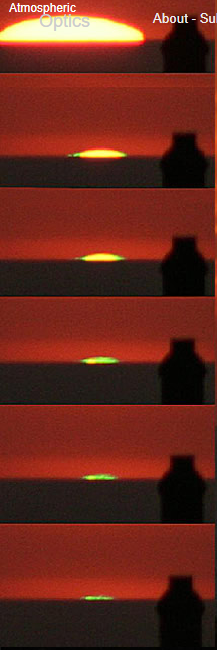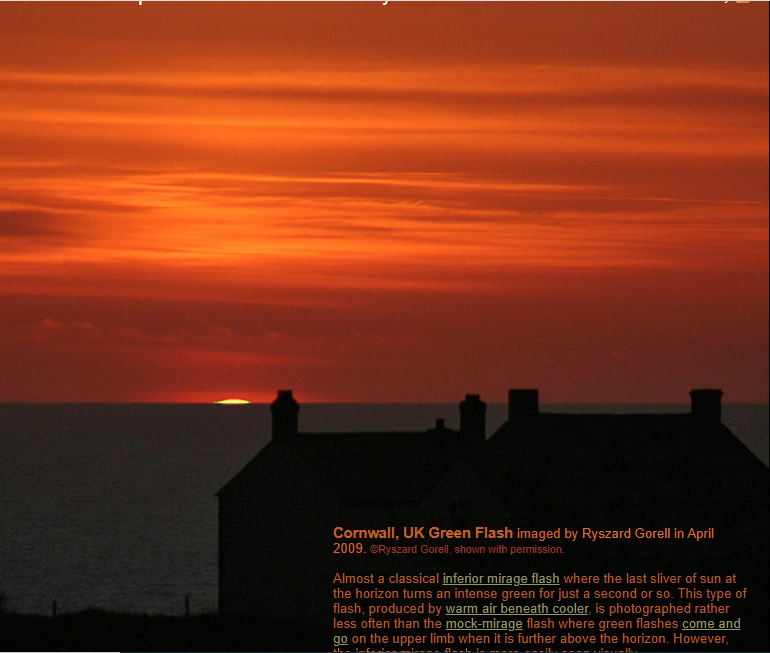Cornwall Green Flash
Cornwall Green Flash: A Rare Atmospheric Phenomenon
Have you ever witnessed a mesmerizing green flash at sunset? If you're lucky enough to be in Cornwall, UK, you might just catch a glimpse of this rare atmospheric phenomenon. While green flashes are often associated with mirages, the Cornwall Green Flash is a unique variation that occurs when warm air lies beneath cooler air. In this article, we will delve deeper into the Cornwall Green Flash, its characteristics, and the factors that contribute to its occurrence.
The Cornwall Green Flash is often described as an "almost classical inferior mirage flash." Unlike the more commonly observed mock-mirage flash, where green flashes appear and disappear on the upper limb of the sun when it is higher above the horizon, the inferior mirage flash is visually more pronounced. During this phenomenon, the last sliver of the sun at the horizon momentarily transforms into an intense shade of green, captivating those fortunate enough to witness it.
But what makes the Cornwall Green Flash unique? While the exact mechanisms behind this phenomenon are not fully understood, there are a few intriguing theories. One possibility is the presence of a narrow inversion layer near the horizon, which creates a ducted mirage effect. This layer may cause the green color to appear on both sides of the main solar image earlier on, adding to the mystique of the event.
To capture the beauty of the Cornwall Green Flash, photographers like Ryszard Gorell have used specialized techniques. Ryszard utilized a Canon 350D camera equipped with a cable release and set to 'burst' mode. By taking rapid-fire shots, he was able to document the elusive moment when the green flash occurred. His stunning images serve as a testament to the fact that a clear sky is not necessarily a prerequisite for witnessing this captivating phenomenon.
While the Cornwall Green Flash is a relatively rare occurrence, it is not exclusive to Cornwall alone. Similar events have been reported in other coastal regions around the world, such as California and Hawaii. These sightings emphasize the global nature of atmospheric optics and the diverse range of captivating phenomena that can be observed in different parts of the world.
To fully appreciate the Cornwall Green Flash, it is important to understand the atmospheric conditions that contribute to its manifestation. The presence of warm air beneath cooler air sets the stage for this remarkable event. When the sun dips below the horizon, its light passes through layers of the atmosphere with varying temperatures. These temperature variations cause the light to refract, resulting in the striking green flash that briefly graces the sky.
Witnessing the Cornwall Green Flash is a truly awe-inspiring experience. As the sun bids farewell to another day, its final moments illuminate the horizon with a vivid burst of green. Whether you are a photographer seeking to capture this phenomenon or simply an enthusiast of atmospheric optics, the Cornwall Green Flash offers a glimpse into the enchanting world of nature's wonders.
In conclusion, the Cornwall Green Flash is a rare and captivating atmospheric phenomenon that occurs during sunset. While similar to other types of green flashes, such as mock-mirage flashes, the Cornwall Green Flash is visually distinct and more easily observed. Its occurrence is attributed to the presence of warm air beneath cooler air, creating a unique environment for light refraction. Although the exact mechanisms behind this phenomenon remain somewhat mysterious, photographers like Ryszard Gorell have successfully captured its beauty through their skillful techniques. Whether you have the opportunity to witness the Cornwall Green Flash firsthand or simply marvel at its splendor through photographs, this natural spectacle serves as a reminder of the extraordinary phenomena that occur in our atmosphere.


Cornwall, UK Green Flash imaged by Ryszard Gorell in April 2009. ©Ryszard Gorell, shown with permission.
Almost a classical inferior mirage flash where the last sliver of sun at the horizon turns an intense green for just a second or so. This type of flash, produced by warm air beneath cooler, is photographed rather less often than the mock-mirage flash where green flashes come and go on the upper limb when it is further above the horizon. However, the inferior mirage flash is more easily seen visually.
Almost classical? Green appears each side of the main solar image earlier on. There 'might' be a narrow inversion layer very close to the horizon producing a ducted mirage.
Ryszard used a Canon 350D with cable release and drive mode set to 'burst'. Some images have been omitted. The images show that a clear sky is not necessary for a green flash.
Note: this article has been automatically converted from the old site and may not appear as intended. You can find the original article here.
Reference Atmospheric Optics
If you use any of the definitions, information, or data presented on Atmospheric Optics, please copy the link or reference below to properly credit us as the reference source. Thank you!
-
<a href="https://atoptics.co.uk/blog/cornwall-green-flash/">Cornwall Green Flash</a>
-
"Cornwall Green Flash". Atmospheric Optics. Accessed on November 26, 2024. https://atoptics.co.uk/blog/cornwall-green-flash/.
-
"Cornwall Green Flash". Atmospheric Optics, https://atoptics.co.uk/blog/cornwall-green-flash/. Accessed 26 November, 2024
-
Cornwall Green Flash. Atmospheric Optics. Retrieved from https://atoptics.co.uk/blog/cornwall-green-flash/.